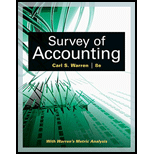
Concept explainers
Concept Introduction:
Decision making plays an important role in the management. The decisions taken by managers are called managerial decisions. Managerial Decisions are decisions taken by managers for the operations of a firm. These decisions include setting target growth rates, hiring or firing employees, and deciding what products to sell. Manager's decisions are taken on the basis of quantitative as well as the qualitative measures. The managerial decision includes the decisions like make or buy, accept or reject new offers, sell or further process etc. These decisions are taken on the basis of relevant costs.
Relevant costs are the costs that are relevant for any decision making. Relevant costs are helpful for take managerial decisions like make or buy, accept or reject new offers, sell or further process etc.
Two basic types of the relevant costs are as follows:
- Out-of-pocket costs
- Opportunity costs
To Indicate:
The additional issues in making decision to accept the business
Want to see the full answer?
Check out a sample textbook solution
Chapter 12 Solutions
Survey of Accounting (Accounting I)
- These are selected account balances on December 31, 2025. Land $180,000 Land (held for future use) $225,000 Buildings Inventory Equipment Furniture $1,470,000 $300,000 $745,000 $150,000 Accumulated Depreciation $570,000 What is the total amount of property, plant, and equipment that will appear on the balance sheet?arrow_forwardThe ledger of American Company has the following work in process account. Work in Process-Painting 5/1 Balance 3,790 5/31 Transferred out ? 5/31 Materials 5,650 5/31 Labor 3,330 5/31 Overhead 2,080 5/31 Balance ? Production records show that there were 570 units in the beginning inventory, 30% complete, 1,630 units started, and 1,530 units transferred out. The beginning work in process had a materials cost of $2,440 and conversion costs of $1,350. The units in the ending inventory were 40% complete. Materials are entered at the beginning of the painting process. a. How many units are in process at May 31? b. What is the unit materials cost for May? c. What is the unit conversion cost for May?arrow_forwardSolve this question general Accountingarrow_forward
- What is the gross profit percentage for the current year ? General accountingarrow_forwardThompson Manufacturing allocates overhead based on machine hours. The following data is provided: ⚫ Estimated Manufacturing Overhead: $450,000 • Actual Manufacturing Overhead: $470,000 Estimated Machine Hours: 30,000 • . Actual Machine Hours: 28,000 What is the amount of over- or under-allocated manufacturing overhead? A) Over-allocated by $30,000 B) Under-allocated by $30,000 C) Over-allocated by $50,000 D) Under-allocated by $50,000arrow_forwardCan you please give me correct answer this accounting question?arrow_forward
 Managerial AccountingAccountingISBN:9781337912020Author:Carl Warren, Ph.d. Cma William B. TaylerPublisher:South-Western College Pub
Managerial AccountingAccountingISBN:9781337912020Author:Carl Warren, Ph.d. Cma William B. TaylerPublisher:South-Western College Pub Intermediate Accounting: Reporting And AnalysisAccountingISBN:9781337788281Author:James M. Wahlen, Jefferson P. Jones, Donald PagachPublisher:Cengage Learning
Intermediate Accounting: Reporting And AnalysisAccountingISBN:9781337788281Author:James M. Wahlen, Jefferson P. Jones, Donald PagachPublisher:Cengage Learning Managerial Accounting: The Cornerstone of Busines...AccountingISBN:9781337115773Author:Maryanne M. Mowen, Don R. Hansen, Dan L. HeitgerPublisher:Cengage Learning
Managerial Accounting: The Cornerstone of Busines...AccountingISBN:9781337115773Author:Maryanne M. Mowen, Don R. Hansen, Dan L. HeitgerPublisher:Cengage Learning Cornerstones of Cost Management (Cornerstones Ser...AccountingISBN:9781305970663Author:Don R. Hansen, Maryanne M. MowenPublisher:Cengage Learning
Cornerstones of Cost Management (Cornerstones Ser...AccountingISBN:9781305970663Author:Don R. Hansen, Maryanne M. MowenPublisher:Cengage Learning



